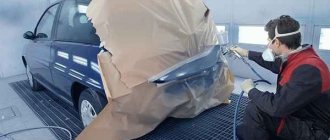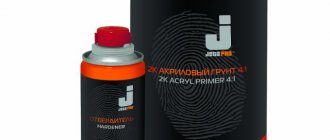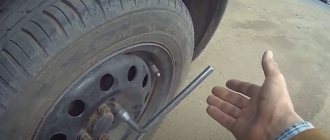Painting work is one of the most expensive pleasures for a car owner, so it is very important to protect the new coating as much as possible from various damages, so that you don’t have to repeat the procedure again soon. To do this, you need to understand the questions of whether it is possible to wash the car immediately after painting, how to operate it, and after what time it is allowed to polish the fresh paintwork.
How long should paint on a car dry and when can you start washing the car?
Have you thought about painting the car body or its individual parts yourself? Then you will definitely have standard questions that many car enthusiasts ask, and in this article we will try to answer them.
How long does it take to dry a car after painting?
As you yourself understand, this time interval directly depends on many factors.
Firstly, this is the temperature regime, which must be maintained at +18 - +22 degrees Celsius. Secondly, it is the type of paint itself. Acrylic enamel and nitro enamel dry quickly enough, and after just a few days you can operate the car. Other types of paints and varnishes require a longer drying period. Thirdly, this is the use of additional equipment in the form of air-heated convectors or IR heaters, which can significantly speed up the paint polymerization process, and you will gain in terms of the time it takes such a coating to dry. Let's look at the approximate time intervals that you will need to carry out the work. If you paint in a garage, the varnish and paint will set in 6–7 hours when using a spray booth or IR panels, and about 1–2 days simply by maintaining the temperature in a ventilated garage. But determining exactly how long the paint on a car dries is quite difficult even for an experienced master. Usually they choose time with a margin so that the car can sit and the paintwork gains the required level of strength, and this is a period of about a week.
How long after painting a car can you drive?
It all depends not only on the type of material, but also on the operating conditions. If you drive carefully, without getting caught in the rain or driving into mud, then after 2–3 days you can use your car. The best option would be to let the car sit for about 14 - 20 days, but not every car enthusiast is ready to leave their vehicle for such a period of time. Such a long term is obtained due to the fact that in addition to the paint itself (base), you also cover the car body with varnish, which also takes a long time to dry. First of all, the varnish dries, and then there is a gradual crystallization and drying of the base itself.
How long after painting can you wash your car?
Experienced professionals advise not to wash your car for a month, especially avoiding high-pressure washing.
This is due to the slow polymerization of the paint under the varnish, and using mechanical force can damage the coating. The minimum period of time after which you can start a car is 15 days. After this period, you can use auto chemicals. Here are some tips for washing your car after painting.
- For the first 15 to 30 days, do not use chemicals to wash your car.
- Do not use a high pressure washer.
- It is better to wash with soft rags or washcloths, and never use hard brushes.
Of course, there are cases when car enthusiasts wash their vehicle at a car wash within a few days. But the question is, are you ready to risk your money? If not, then it's better to wait.
When and how can you wash a car after painting and how long does it take for the body to dry?
Painting a car body is an expensive procedure, so owners try their best to protect the new paintwork from damage. While the paint on the car dries after painting, its surface is damaged by the slightest mechanical or chemical impact.
Make sure that the paint does not get on the headlights. When a fresh paint coating dries, polymerization of the substances included in its composition occurs - this process is called crystallization.
Before final drying, you need to provide special care to the car and protect the body from the influence of adverse factors.
General rules for operating a car after painting
The whole point of proper operation of a newly painted car is based on the fact that the applied layers of paint and varnish crystallize . About a couple of days after painting, only the top layer—the varnish—sets. However, there is still uncured base paint underneath for several weeks. It takes so long to dry because the crystallized varnish prevents the normal volatilization of the solvent.
Accordingly, not fully hardened varnish and very “weak” paint underneath can be damaged quite easily. Scratches, clouding, cobwebs and even chips remain without much effort on a fresh coating. Subsequently, most of these defects cannot be restored by simple grinding and polishing - local painting is required, which is not so easy and cheap.
In general, immediately after painting, it is recommended not to drive the car at all for at least two weeks . This time largely depends, of course, on the brand and manufacturer of the paint and varnish used, and can vary in one direction or the other. But on average, standard paints and varnishes crystallize sufficiently within two weeks.
If it is not possible to keep the car in the garage for such a long time, then at least for the first time you should avoid off-road trips outside the countryside, especially in bad weather. Dust, dirt, sand, small stones - paint that has not yet hardened simply cannot resist all this. The same applies to the winter period. At sub-zero temperatures, fresh paintwork takes even longer to harden.
In the first weeks after painting, it is strictly not recommended to use various devices for brushing off dust. Be it super-soft microfiber, a special brush or other means - on fresh varnish, together with large particles of dust, all this turns into a fairly effective abrasive. The result of such care can be clouding and the appearance of the so-called cobwebs.
The first time after painting, you should also not allow the car to park for long periods in direct sunlight . Under the influence of ultraviolet radiation, a coating that has not yet formed can easily fade, lighten, or even change its shade beyond recognition. This is especially true for inexpensive paints and varnishes.
You should also avoid driving on roads that have been recently paved or (most likely) that have undergone so-called resurfacing . If bitumen gets on fresh paint, you will inevitably want to wash it off. And this can only be done with the help of solvents, which can easily wash off not only the resin, but also fresh paint.
Even if all of the above happened - your car was damaged by dust, dirt or bitumen - you should not rush to remove all this, so as not to spoil the effect of a newly painted body. It is better to endure it and leave everything as is for the indicated couple of weeks, after which any dirt can be removed using traditional methods.
Common questions from car owners
Car owners have many questions related to caring for their vehicle after painting. Let's answer the most common ones.
How long does it take for a car to dry after painting?
The time required for crystallization differs among different paints. Only acrylic paint on cars dries quickly; for other products, the drying time is 14-28 days. It takes the same amount of time as paint to dry on a machine. To find out the drying time for a specific product, check the package instructions.
When can you wash your car after painting?
The car can be washed carefully after the paint has completely dried. The time required for crystallization of each composition is indicated by the manufacturer on the packaging. The first 2-3 washes are performed in a special way.
How to properly wash a car after washing?
The first car wash after painting should be gentle on the paintwork. Below are the basic rules for its implementation:
- When washing for the first time, it is better not to use detergents. If the body is very dirty, you can use special car detergents. Do not wash the car after painting with household products (washing powder, soap solution, etc.), as they react with wet paint and cause it to fade.
- For the first wash, only soft sponges can be used. Brushes, even those with soft bristles, will leave marks on the surface. Do not use sponges that were used to wash the car before painting. The dirt particles contained in their pores scratch the fresh paint.
- Do not wash the car after painting using high pressure washers. Use a hose that supplies cold or slightly warm water with low pressure. If you don't have a hose, a garden watering can can be useful, just keep in mind that it will take a lot of water to thoroughly rinse the surface.
- Do not dry the car naturally after painting it. Calcium and magnesium salts contained in tap water, when dried, form whitish spots and streaks that eat into car paint. It is better to blot (not wipe!) the body after washing with soft napkins.
How to properly wash a car after painting?
For the first time after painting, wash the car as follows. The surface of the body is moistened with water from a hose or watering can. Apply detergent to a damp sponge, gently wipe the car, and then rinse thoroughly. It is better to treat one side of the car, and after rinsing, the other. In this case, the detergent composition will not dry out and will be washed off more easily.
Selecting a detergent
If in the first weeks after painting there is a need to clean the surface of the body, it is carried out without the use of detergents. For severe stains that cannot be removed with water and a sponge, you need to choose the right detergents for cars.
Gentle car wash products contain silicone or wax. These substances form a thin film on the surface of the body that protects the car from moisture, sun, mechanical damage and other negative factors. Dirt sticks less to a car treated with these compounds, so the washing procedure can be carried out less frequently. Another advantage of products containing wax or silicone is the shine of the body after their use.
Attention! Some car wash products can seriously damage wet paintwork. To avoid unpleasant surprises, carefully read the instructions on the package or consult with the seller before purchasing.
How exactly should you wash your car? Some useful tips for choosing a good detergent
Drivers often wonder what to wash their car with after painting. Indeed, it is very important to choose a suitable detergent for your car. We are happy to bring you the answer.
girl washes car
There are several types of products on sale that allow you to carry out high-quality car washing after several weeks after painting, as well as in the future. Depending on the season, you can choose:
- Cleaning products based on silicone. They allow you to create the thinnest film on the surface of the coating, which will subsequently protect it from all kinds of damage. Such products are often used during the autumn-winter period.
- Polishes and car shampoos. In this row you can see shampoos that can polish the surface of a car (they are based on wax). The result of their use will be an additional shine to the car. A good example of such a product is ZipWax shampoo. There are also car shampoos that prevent corrosion. They will help you protect your car from traces of rust.
Washing after polishing
Polishing a car involves applying a composition to the surface of the car body that adds shine. Therefore, care after polishing should be the same as after painting. The main difference is that the final hardening time of the polishing composition on the paintwork is 2-4 days, after which it is not susceptible to mechanical damage.
You can use car washing and care products no earlier than 8 days after polishing. The technology for the first washes after polishing is the same as after painting.
Why is varnish applied to the body?
No one will simply apply varnish to a car body; this serves several purposes:
- Giving the painted surface of the car a special shine, gloss, and depth of color.
- Performs protective functions against paint damage by mechanical and chemical means.
- It is possible to repeatedly restore the paint surface by polishing or grinding.
- The service life of the coating after painting is extended.
In addition, it should be noted that varnishing a car after painting will not allow the base layer to fade under the influence of ultraviolet rays. In addition, the body is not afraid of the effects of salts used to treat the road surface.
Specifics of coating and drying of various types of car varnish
The composition that was previously used to coat the car body was a cellulose-based mixture. It was no longer used due to lack of shine, flammability and loss of color transfer ability.
Another option was glypthal coating. It is applied without a special chamber in a well-ventilated workshop where there is no dust. This composition takes a long time to dry. Drying of the varnish is accelerated by an activator, which improves the resistance of the coating to various damages. In addition, a light thinner is added to the coloring composition.
Hot painting allows you to reduce the drying time. To do this, the varnish is heated to +70°C and applied to an already heated surface. In this case, no thinner is added.
The third type of varnish is polyurethane. It is used with a special hardener, which accelerates the setting of the coating. The substance must be dissolved in the varnish 10-12 minutes before painting.
The composition is sprayed in 3 layers:
Before applying the second and third coats of paint, you must wait 15 minutes for the car to dry. The third one will take about an hour to dry.
A common type of paint and varnish coating (LPC) is acrylic, which can be:
- thermo-hardening (the composition is used in factories, because it dries at high temperatures);
- thermoplastic (the substance dries when the solvents have completely evaporated).
LCP does not lose its properties when properly stored. The conditions under which the product must be kept and the expiration date are indicated on the packaging. Due to severe frost or heat, the liquid may become cloudy, separate, and will flake off after painting. Opened autovarnish is stored for 3-6 hours at +20°C.
Drying features depending on equipment
The top layer hardens in 6 hours if no additional equipment is used. The paint hardens completely within a day. The exact drying time is indicated on the packaging.
The adhesion also depends on the drying method, for which special devices are used. They speed up the drying of the paintwork.
Convection method
The method allows the paint to dry quickly. The process is accelerated due to the large amount of heat flowing to the machine. The convection chamber functions like a fireplace with a fan, but the air is evenly distributed over the surface and does not go further.
The enamel dries quickly, but does not affect the adhesion of the paint to the surface of the car body.
Infrared method
In most cases, drying is carried out using the infrared method, which covers a space of 20-30 cm. The device is plugged into the network, but there are devices with a battery. The distance from the painted surface to the lamp should not be more than 50 cm. The device contains a cassette that changes the position of the device.
If the car is in a small garage, then take a compact device. In this case, the dried area of the painted surface will be small. Some models have a timer. It can be used to determine the drying time of paint and surfaces after painting.
Drying in a thermal chamber
In the thermoradiation chamber, drying occurs using infrared radiation. It comes from panels that are heated by gas, incandescent lamps and other elements. The temperature of the source affects the infrared wavelength and its length.
A flameless gas burner with ceramic nozzles that heat up and emit infrared radiation has a similar effect. This wave hits the coloring composition, and the metal is strongly heated.
Experts recommend not washing a painted car for a month. Due to the slow hardening of the paint under the varnish, damage to the coating may occur due to mechanical impact. The car should be washed no earlier than after 14 days.
To avoid damaging the paintwork, you do not need to:
- use chemicals to wash the car for the first 14-30 days;
- clean the surface with strong water pressure;
- take hard items to wash your car, giving preference to soft fabric.
Preparing the equipment
To avoid wasting time, prepare the necessary equipment and tools in advance.
So, you may need:
1. Portable spotlight.
High-quality lighting from all sides of the car is very important. Otherwise, you may not notice the difference in shades and ruin your work.
The ideal option is to illuminate the car from all sides.
2. Vinyl drill bit.
A useful thing for removing old corrosion on a car body. With its help you can quickly remove excess paint, areas with severe rust, putty and primer.
The advantage of such nozzles is that they do not heat the surface and do not harm the metal.
3. Construction hair dryer.
A reliable assistant if you have to remove moldings from your car, various stickers or decorative components. In general, everything that is held on by glue is easier to dismantle after proper heating.
4. Orbital sander.
Very useful for preparing the body for putty and leveling the body before painting. In addition, a grinding machine will also come in handy at the final stage, when polishing.
5. Polishing machine.
Can speed up the body processing process after all work is completed
In addition, find (buy) foam pads (it is important that they have different densities) and sheepskin polishing pads
6. Painting mask.
Essential if you care about your health. Paint and varnish emit dangerous and harmful fumes that should not enter the lungs. You can buy this product or ask your friends.
7. Painting gun.
One of the main tools for painting the body. With its help you can apply paint, varnish and even liquid primer or putty to your car.
8. Not a big paint gun.
The small size is useful for touching up small areas. The nozzle diameter is about a millimeter, so you can set up a “torch” the size of a ten-kopeck coin.
9. Compressor.
One of the most important elements. Without it, it is impossible to paint the car body efficiently and quickly. Of course, it makes no sense to buy it for a one-time job. If you wish, you can rent equipment or look for it from friends.
But that is not all.
You will need a lot of related materials:
1. Abrasives:
- sandpaper for a plane, sandpaper with different grain sizes and densities;
- grinder wheels.
2. Putty.
You will need a universal type, finishing, with fiberglass (works well with deep scratches) and nitro putty (finishing, one-component).
By the way, with the help of nitro putty it is much easier to remove small paint drips after the work is completed.
3. In addition, you will need:
- acrylic primer;
- polishing pastes (of various types);
- wet wipes (help remove grease from the surface);
- antisilicone (also used to combat fat);
- developing powder (to identify all defects);
- matting paste;
- masking tape.
When can you polish your car after painting?
Using polishing, imperfections that appeared during painting are removed and the new coating is protected. The procedure is carried out when the paint or varnish has completely crystallized. Most irregularities appear on a car after painting. In this case, the risk of damaging the fresh layer of enamel is reduced.
Polishing can be of 2 types:
In the first case, polish is rubbed in, which is a special composition for polishing. When defects appear after painting, abrasive treatment is carried out. This method allows you to remove imperfections by grinding with a polishing machine and using an abrasive substance. Work begins with small elements of the machine.











